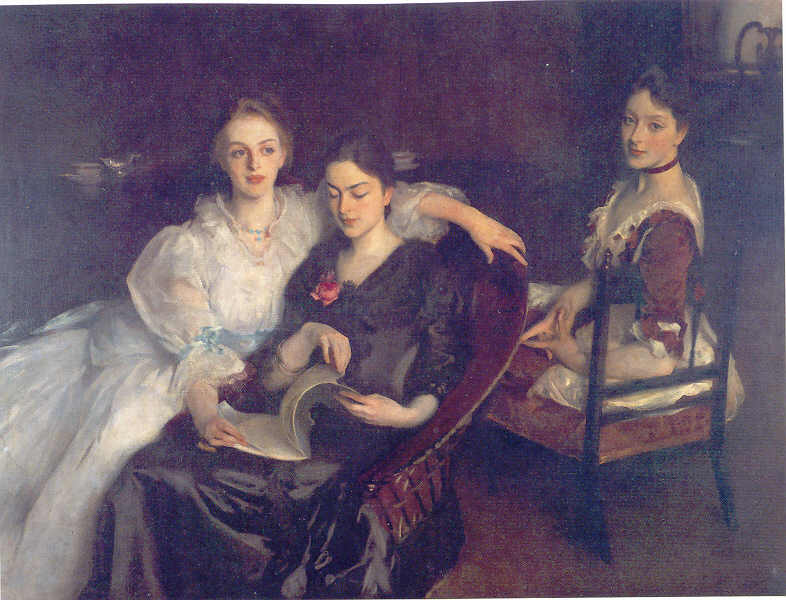|
The
Misses Vickers
John
Singer
Sargent -- American
painter
1884
Sheffield
Galleries
and Museums Trust, England
Oil on
canvas
137.8
x 182.9 cm (54 1/4 x 72
in.)
Jpg:
Carol
Gerten's Fine Art
From left to right:
Florence Evelyn
"Evelyn" (18 years old), Mabel Frances (21 years old), and Clara
Mildred
"Mildred" (19 years old)
When Sargent showed
the painting
at the Paris Salon in May of '85, they snubbed it and called it
"pseudo-Velasquez."
When he showed it the following year in London at Royal Academy's
exhibition
of '86, it was voted the "Worst Picture of the Year" by The Pall Mall
Gazette
visitors poll. Critics called Sargent use of perspective with
"Mildred's"
turned body, the angled chairs, the relative closeness of the figures
in
the foreground and the distant items in the background as a "juggler's
trick," "shallow and pretentious." It didn't at all fall in line
with the neat and evenly distributed figures in Lawrence Alma-Tadema's
neo-classical theme of Roman baths entitled "An
Apodyterium" which was the Gazette's winner for best picture
that
year.
Parallels are often
drawn between
Velazquez's dark tonal work and Sargent's The Misses Vickers.
Certainly
we see similarities in tone, the use of depth, and the light near the
back
of the room (upper right -- but difficult to see in this image) which
he
had also used in Daughters
of Edward Darley Boit; but there is also the influence from the
"spontaneity" of Frans Hals (whom Sargent also studied with equal
enthusiasm)
particularly in the group portraits of his Banquet
of the Officers which was totally missed by the English
public.
Sargent has no
intention of giving
us a neo-classical or a Pre-Raphaelite scene where our eyes can wonder
aimlessly and equally over any point in the depth of the picture. This
is a tight, modern image of three modern girls. Though they sit there
obviously
posed, there is an unmistakable naturalness about them. We see
"Evelyn's"
arm around her older sister sharing a magazine and we intuitively
understand
it to be correct. We see "Mildred's" arm resting over the back of her
own
chair with her hand woven back through onto her lap and we say "Yeah,
that's
right. I would do something like that."
Sure, the painting
is posed, we understand
that. But we can almost sense Sargent talking to them about how
"Mildred"
needed to have her chair closer. Mable sits patently and quietly
flipping
through her magazine, and "Evelyn's" thoughts drift to boys and other
places.
There is a sweetness and truthfulness about the whole thing that speaks
so honesty about these girls, all bathed in that melancholy darkness of
some of Sargent's more powerful works.
Sargent has done
it! He has taken
that incognizance of an instant -- that captured moment of Frans Hals
and
he's given it right back to us in the form of The Misses Vickers.
A juggler's
trick?
No!
It is near
perfection personified
in the balancing of so many difficult elements. That the public didn't
get it, seems astounding to me. It must have been crushingly depressing
to Sargent since he had given it his all -- and it coming on the heels Madame
X. It really wasn't all that different in
theme from his Boits Daughters but it showed Sargent just how
much
Paris had turned
on him, and how inhospitable the English were to his French style.
Not all reviews
were negative. Friends
of his such as R.A.M. Stevenson (who studied with John in Paris)
rallied
to his support when he wrote for the American audience in The
Magazine
of Art, and Henry James, again later for the American Audience in Harpers.
It would take some time, but critical acclaim would eventually come
around
to a shared consensus that this was one of Sargent's most significant
portraits.
* *
*
An image can't ever
replace the real
painting and you can't see the brush work of Sargent but it's
fascinating
to read about his technique:
Report on the
Painting Technique
By Mark Roberts
Sheffield City Art
Galleries
Conservation Department
Sargent
has used a Parisian,
commercially prepared canvas with an off-white oil ground for this
large
triple portrait The Misses Vickers. The canvas grain is very
important
in his design; the painter uses its surface texture like 17th century
masters
such as Velasquez. Sargent’s technique was founded in this 17th century
tradition, starting the painting with thin washes of colour to
establish
the broad and dark masses, then building up half-tones. It is these
half
tones of underpainting, forming the shadows, which are enhanced by the
canvas grain showing through. Further oil paint was applied in a very
rich
manner, and the dashing highlights were achieved with well loaded brush
dragged over the canvas grain. This helped to create the tension, the
movement
and restless quality of an otherwise seemingly domestic scene of
tranquility.
Sargent made a
number of small but
important adjustments to the poses of the three sisters. There are
pentimenti,
ghosts of alterations, showing through the top layer of paint,
particularly
around the right hand of the central figure, and the left hand of the
figure
in the white, resting on the sofa back. He has applied too much paint
to
these areas and this, perhaps, had partially dried. It could not be
scraped
off so he applied an oil glaze over the impastoed paint to give it
greater
contrast, and this produced the effect of paint dragged over the canvas
which is characteristic of this painting. It must be stressed that,
although
there are some pinpoints of wear in the paint layer, this broken
surface
of paint is a deliberate effect. This was achieved, for example, by
trapping
the brown tone between the canvas and half covering with a heavy
highlight
(q.v. the side of the central figure’s neck), or by use of linseed oil
scumbled over half tones and over highlights to tone them down (q.v. in
the lace cuff of the figure on the left).
There are other
alterations of proportion
to the heads of the ladies, a problem indeed, considering the
experimental
perspective. Sargent had proceeded too far with the portraits to
consider
scraping back to the canvas, so he painted over the already oil-rich
paint,
and as the new layers had nothing to key into, they pulled away from
one
another during the drying phase, thus causing the large cracks in the
paint
layer. This air of speed (the painting was completed in 3 weeks) also
manifests
itself in the background, as here to a lesser degree there are smaller
oil drying cracks due to too much linseed oil in the underpaint and in
the top layer.
(The Misses
Vickers, The Centenary
of the Painting, by John Singer Sargent, Sheffield Arts Department,
July
1984, p.64)
Notes:
Exhibitions
John Singer
Sargent,
An Exhibition -- Whitney
Museum, NY & The Art Institute of Chicago 1986-1987
- I am deeply
grateful to G.W. and W.D.
Hawksley of Sheffield England, both friends
of the JSS Gallery, for sending me "The Misses Vickers Centenary"
booklet.
It was published by the Sheffield Arts Department in July of 1984 on
the
centennial of the painting and written by James Hamilton.
- See the year
in
review 1883-1884
- See Sheffield
Galleries and Museums
Forum:
Subject: Favorite
Sargent
From: Mark Heumann
mhe um ann@resourcedev.com
Date: 3/30/2001
The Misses Vickers
- reminds me of
Cranach's (Durer's?) painting of the three daughters of the Elector of
Saxony  located
at (Kunsthistorisches) . . . My own impression, seeing it in the
Kunsthistorisches,
was that one girl was going to get into trouble, one would go along,
and
the third would try to reign the other two in. Consider reading the
personalities
of the Misses Vickers. Which one has the imagination? Which is
compliant?
Which proper? located
at (Kunsthistorisches) . . . My own impression, seeing it in the
Kunsthistorisches,
was that one girl was going to get into trouble, one would go along,
and
the third would try to reign the other two in. Consider reading the
personalities
of the Misses Vickers. Which one has the imagination? Which is
compliant?
Which proper?
|

